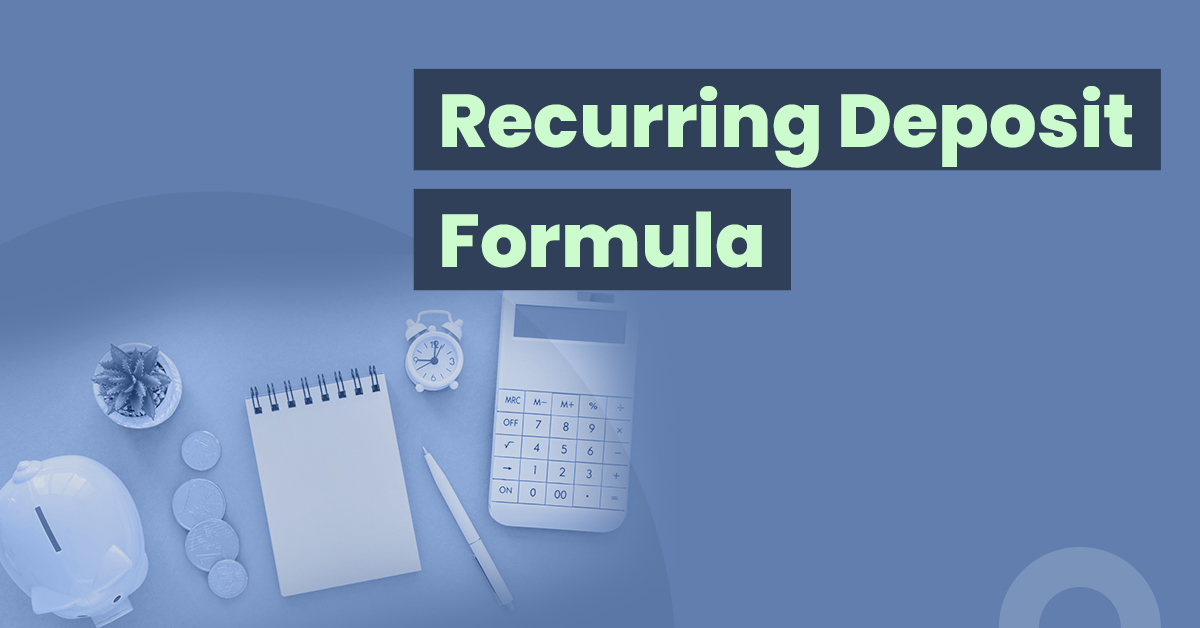Formula to Calculate Recurring Deposit (RD) Maturity Amount


A recurring deposit scheme is a systematic saving scheme that allows you to invest small amounts regularly and build up a corpus. Like fixed deposits, recurring deposits give assured interest income on your savings. However, unlike fixed deposits, recurring deposits do not require a lump sum investment. Under these deposits, you can save in instalments to cultivate a savings habit.
Banks, post offices, and Non-Banking Financial Companies (NBFCs) offer recurring deposit schemes. While the scheme is similar across these financial institutions, the interest rates differ. Therefore, it would be best to compare the interest rates and choose a scheme with the highest rate. You can also calculate the interest income through a recurring deposit formula. Let’s understand the formula that calculates the interest.
How to Calculate the Maturity Amount of RD?
The financial institution mentions the interest rate of the RD. To calculate the interest income, you can use the following recurring deposit formula –
A = P {( 1 + R/N)} ^ (N * t)
In this formula, the inputs used are as follows –
- A – Amount on maturity
- P – The amount invested each month (principal amount)
- R – Rate of interest
- N – The number of times the interest is compounded annually
- t – Tenure of the deposit
The formula computes the amount for each month. You have to calculate the monthly amount for each month and then add all the amounts to get the maturity value at the end of the tenure.
Let’s understand this with the help of an example:
Say you deposit Rs.1000 every month for 36 months. The interest rate is 7% per annum, and the interest is compounded half-yearly.
In this case, the amount after the end of the tenure would be calculated as follows –
P – Rs.1000
R – 7% = 0.07
t – 36/12 = 3 (The amount invested in the first month will get compounded for the whole 3 years. For the second month tenure will become 35/12 and so on.)
N – 2 since the interest is compounded twice in a year
Using the values in the recurring deposit formula, the monthly amount is calculated as follows –
Amount for the first month = 1000 (1 + 0.07/2) ^ (36/12*2) = Rs.1229.25
Amount for the second month = 1000 (1 + 0.07/2) ^ (35/12*2) = Rs.1222.22
Amount for the third month = 1000 (1 + 0.07/2) ^ (34/12*2) = Rs. 1215.24
This way, the amount for every month is calculated for 36 months. The monthly amounts are added up to give the maturity amount. In this case, the maturity amount will be Rs. 40,099 with a total accrued interest of Rs. 4,099.
What are the Factors that Affect the RD Interest Rates?
Several factors affect the RD interest rates. These are as follows –
- Term of deposit
The term of deposit depicts the duration over which you would deposit into the scheme. Financial institutions offer different rates at different durations. So, your interest rate would depend on your selected duration. - Depositor’s age
Senior citizens enjoy a higher interest rate on their deposits. So, if you are a senior citizen or open a RD account in the name of a senior citizen, like your parents, you can earn a higher interest rate. - Compounding frequency
Compounding frequency means the number of times the interest is compounded during a year. The frequency determines your effective annual interest rate. The higher the frequency, the higher the interest income you can earn throughout the tenure.
Final Thoughts
Recurring deposit schemes are considered as a safe investment option and they are not exposed to market volatilities. Moreover, with regular savings, you can create a decent corpus for your financial goals. Multiple financial institutions offer the RD scheme, so you will have a choice in selecting the scheme. Compare the schemes across institutions, calculate the potential interest income you can earn using the RD interest formula or online RD calculator, and then invest in a scheme that offers the highest returns.
FAQs
Is the RD interest taxable?
Yes, the interest income you earn from an RD account is taxable. It is clubbed with your gross taxable income and taxed at your income tax slab rates. For instance, if you earn an interest income of Rs.1000 from the RD account and fall in the 20% tax bracket, you would have to pay a tax of Rs.200 on the interest income. The bank deducts a TDS of 10% on the interest earned on RDs if the interest amount exceeds Rs. 40,000 (Rs. 50,000 for senior citizens).
What is the frequency at which interest is compounded in an RD scheme?
The compounding frequency depends on the financial institution and the type of RD scheme you have selected. Some schemes compound the interest annually, while others offer quarterly compounding, yielding higher returns.
What is the interest rate that I can earn?
The interest rate depends on the amount deposited, your age, the type of scheme you have selected and the deposit tenure. Moreover, the rate varies across financial institutions. So, you would have to check for the actual interest rate you can earn depending on your deposits and the institution you choose.
What is the minimum and maximum investment required for an RD account?
The minimum and maximum amounts depend on the financial institution offering the RD account and the type of account you choose. In some cases, a minimum of Rs.100 is sufficient, while in others, the minimum limit might be Rs.1000.
The maximum investment limit also varies across financial institutions. Please check these investment limits before investing.
Which banks offer the RD scheme?
Almost all banks offer the RD scheme for regular investments and assured returns.




